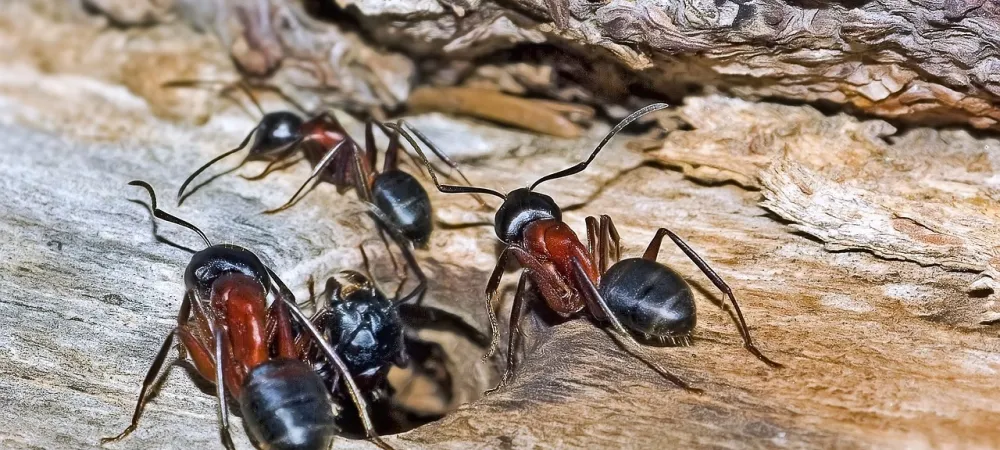How To Get Rid of Carpenter Ants

Carpenter ants can damage your home if not addressed promptly. Fortunately, there are proven methods for getting rid of them. In this article, we will explore strategies to eliminate carpenter ants. From natural remedies to professional pest control services, we will cover options for different preferences and budgets. By understanding their behavior, you can choose the best method to eradicate them and prevent further infestations. Let's discover the best solutions to bid farewell to these pests.
What Are Carpenter Ants?
Carpenter ants are wood-excavating insects that can cause significant damage to wooden structures. They differ from other types of ants in their nest-building activities, as they create nests by excavating tunnels and galleries in wood. This behavior can lead to structural damage if left unchecked.
What do carpenter ants eat?
Carpenter ants are primarily nocturnal and are known to forage for food at night. They are omnivorous, feeding on a variety of food sources including insects, sweet foods, and even dead animals. Their preference for sweet substances can lead them to infest areas where they can find sugar, such as pet food bowls or stored sweets.
Signs of a carpenter ant infestation
One of the key indicators of a carpenter ant infestation is the presence of sawdust-like wood shavings (known as frass) around or near wooden structures. This frass is the result of the ants excavating tunnels and galleries within the wood.
Additionally, carpenter ants create scent trails that other ants in the colony can follow, leading them to food sources.
Carpenter Ants vs. Termites: Understanding the Key Differences
When it comes to wood-destroying pests, two common adversaries are often mistaken for one another: carpenter ants and termites. While both can cause significant damage to wooden structures, it is important to understand the key differences between these two pests in order to implement effective and targeted control measures.
The most notable distinction between carpenter ants and termites lies in their feeding habits. Termites are known for their ability to consume wood as their primary food source, leading to extensive structural damage. On the other hand, carpenter ants do not eat wood but instead excavate it to create nests and galleries.
One way to differentiate these pests is by examining their physical characteristics. Carpenter ants have a distinct body shape, with a narrow waist and segmented body. Termites, on the other hand, have a more uniform body shape and lack the pronounced waistline seen in carpenter ants. Additionally, carpenter ants possess bent antennae, while termites have straight, beaded antennae. Lastly, when it comes to wings, carpenter ants have longer front wings and shorter hind wings, while termites have wings of equal length.
Effective DIY Ways to Eliminate Carpenter Ants
If you have noticed signs of a carpenter ant infestation, such as wood shavings or sawdust near wooden structures or the presence of winged carpenter ants, it's important to take action to eliminate the problem before it gets worse. While calling a pest control professional is often the best course of action, there are some effective DIY treatment methods you can try first.
Find and destroy the nests
Carpenter ants make their nests in moist wood, like tree stumps or damaged wood on your property. To locate the nest, follow the scent trails left by worker ants. These trails will be lines of ants going between the nest and a food source. Once you find the nest, you can remove it by vacuuming or treating it with insecticide dust. Wear protective clothing and follow the instructions on the insecticide dust.
Apply boric acid
You can use non-toxic alternatives if you don't want to use chemical pesticides in your home. Boric acid is a potential solution as it is harmful to ants but does not pose a risk to humans. Sprinkle it in areas where you see carpenter ants or near their nests. Another method is to make homemade ant bait with borax and a sweet substance like honey or sugar. Place the bait near ant trails, and the worker ants will take it back to the nest and eliminate the colony.
Use commercial ant bait stations
These bait stations have a sweet substance and slow-acting poison. Worker ants carry the poison back to the nest. Place the bait stations near ant trails or where you've seen carpenter ants. Be patient, as it takes time for the bait to work.
Schedule a Carpenter Ant Inspection With Frontline Today
If your DIY treatment methods have been unsuccessful in eliminating a carpenter ant infestation or if you suspect multiple active nests, it is advisable to call in a professional exterminator. Carpenter ants can be difficult to eliminate completely without professional assistance, and their presence can lead to significant structural damage. By enlisting the help of a professional, you can ensure that the infestation is effectively treated, reducing the risk of further damage and ensuring the safety of your home.

